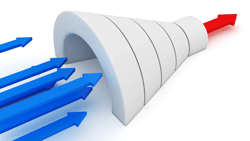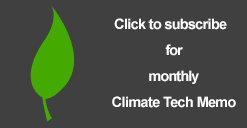Inbound marketing – get started, get better leads

Ron asked if his website could be better organized for sales impact – i.e. could “Inbound marketing” help his B2B sales business? His site had a good deal of material on the company’s area of expertise. Most of it focused on one call-to-action: “Call us, we’ll be happy to talk.” Would that be perceived as an invitation to talk with a Salesman? Would that work? What followed was a brief discussion of current buyer behaviors – and how to get started on adapting your website to the search economy.
Buyer Personas – We all sell to a typical buyer – defined as an industry, a role or title, a demographic, a set of problems to solve, as set of business values, and even a personal life outside work. These personas need to be defined. The first draft can be based on your experience, then interviews of real people in those roles must be done, to validate the problem space and confirm which buyers drive your revenue.
The Buyer Journey – There are several stages in the buyer journey. To really simplify, the three main stages are Awareness, Consideration, and Decision. Awareness is a learning stage where a B2B suspect feels the symptoms of a problem achieving business goals – since the problem is typical in his/her industry, they seek (via Internet search) some ways to better understand the problem(s). Then a buyer gets into Consideration – they have named the problem, and are trying to learn more about solutions available. Is there some expert information that can help? Are there products and services that can help? Lastly, the Decision phase is when a user has a solution strategy and has moved into action. They now want details of product features, costs, and how to trial or acquire a desirable solution (…your solution!…).
Sharing Knowledge via Content – the role of “Content” is vital – even in the search economy, buyers have that old-fashioned habit of asking themselves “does this vendor really know their stuff?” The most efficient way to answer is by offering content that answers questions – and does not start pitching your product. Well, not always pitching! You need to organize and tune your content around the 3 phases of the buyer journey. Awareness content covers symptoms of industry problems to be solved. and typical approaches (no product pitch). Consideration content covers problems in more depth, and permits talking about case studies to solve those problems, and your product category and offers in context. The Decision content gets directly to your product, offers and differentiation – this is where Ron started to see how his content needed to be sorted out as to where it fit in the buyer journey.
Call-to-Action – With content mapped to Buyer Journey, you now need a matching Call-to-action (CTA) to follow each piece of content. Each CTA leads to a specific landing page – making data available to you on which paths users follow, helping confirm or correct your buyer interest assumptions.
What’s next – Content is obviously critical to this Inbound marketing process, yet most companies already have lots of great content, and produce more of it every week. What we have covered here is just the starting point. For further insight, take a look at a study done on how 351 B2B companies use inbound marketing tools – covered in our recent Webinar on Lead Generation. We’ll be following this with more info on Inbound marketing tools and techniques.



Follow Us
Follow us on LinkedIn for updates.